Alaska Fish & Wildlife News
June 2021
Rabies Outbreak in Western Alaska
Sparks Team Response
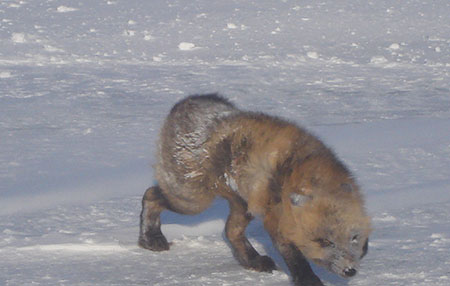
Several State of Alaska Departments, federal and local authorities came together in March 2021 to address a recent rabies outbreak in Nome. Alaska’s response to this crisis followed the One Health concept - recognizing that the health of people, domestic and wild animals, as well as the environment, are all intertwined and should be addressed in a collaborative and coordinated fashion.
Arctic fox rabies is enzootic in populations of arctic and red fox populations along Alaska’s northern and western coasts. This means rabies is always present in these populations at some low level but periodically there can be outbreaks called epizootics (an outbreak in animal disease rather than an epidemic as is it is called when occurring in a human population). However, the winter of 2020-2021 ushered in a widespread outbreak with persistent and large focus in and around Nome.
The first cases in red foxes were recognized in September 2020 when Alaska Department of Fish and Game (ADF&G) biologists Bill Dunker and Sara Germain, based in Nome, began responding to reports of foxes acting strangely. The behavior included shaking or seizuring, as well as coming into dog yards and attacking dogs, and often foxes were killed by dogs. Foxes that showed the classic signs of rabies were killed as DLP (defense of life or property) to protect the dogs and human health. Unless the fox tests negative for rabies, any dogs or people exposed to saliva or brain matter of a fox must undergo treatments including a three-shot vaccination regime.
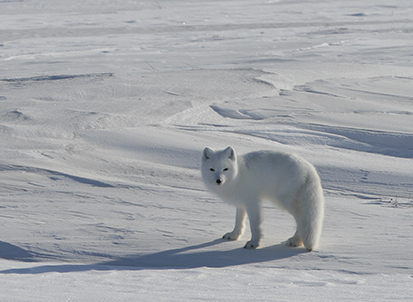
The first rabies-positive red fox was confirmed by the Alaska State Virology lab on October 6. Through March 1, 2021, six additional fox cases were confirmed, and most of these put dogs at risk and unfortunately, lead to the euthanasia of several dogs that were unvaccinated against rabies. Dogs with a current rabies vaccination underwent a 45-day quarantine. An additional six foxes were seen exhibiting rabies behavior such as chasing vehicles, biting at themselves or objects, having seizures, or approaching people without fear, but were not tested.
During this initial outbreak, ADF&G Nome biologists worked with ADF&G Wildlife Health Veterinarian Dr. Kimberlee Beckmen. Other health professionals including Dr. Louisa Castrodale with the Alaska Department of Health and Social Services (DHSS) Section of Epidemiology; Dr. Robert Gerlach, the State Veterinarian in the Alaska Department of Environmental Conservation (DEC); and Rachel Lee of the Norton Sound Health Corporation, worked together to expedite collection of carcasses, shipping, testing and response to exposed dogs. The Centers for Disease Control and Prevention in Atlanta assisted in confirming that the rabies strain in the red foxes was the same Arctic fox rabies.
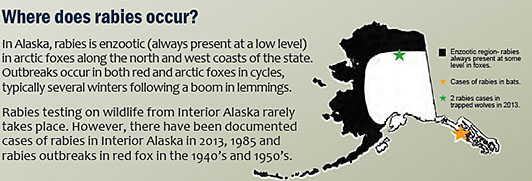
The city of Nome and others locally assisted with a campaign to raise public awareness and increase vaccination of dogs. This included several vaccination clinics conducted by the Alaska Native Veterinary, Inc. over the winter. Gay Sheffield with the University of Alaska, based in Nome, arranged a Bering Strait Science Zoom presentation for Dr. Beckmen to address people in the area about the rabies situation in Nome.
The increasing number of reports of red fox and Arctic fox acting abnormally, in addition to the growing number of laboratory confirmed cases of rabies, threatened the health of both dogs and people - most Alaskans exposed to rabies are from dog bites, indirectly from a dog exposed to a rabid fox. More action was deemed necessary to get this outbreak under control. ADF&G then contacted Marc Pratt of USDA Wildlife Services in Palmer to enlist their staff and funding through the USDA Wildlife Services National Rabies Management and National Disease Programs, to help mitigate the threat of exposure to rabid foxes. The plan was to remove foxes in and around Nome, thereby reducing the population and decreasing the transmission rate among wild foxes. This would in turn reduce the risk of encounters between potentially rabid foxes and dogs or people. All removed foxes were tested for rabies. Hunters and trappers were requested to submit the heads of harvested fox to ADF&G to be included in the testing. This increased testing was conducted to help determine the prevalence of rabies in the fox population around Nome.
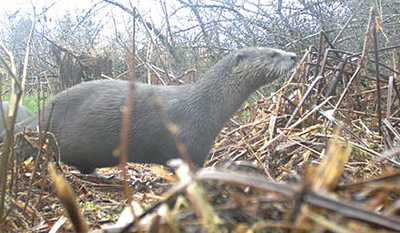
While the largest numbers of foxes collected and tested for rabies were found around Nome, there were also fox rabies cases in villages in the region and on St. Lawrence Island. The St. Lawrence Island picture was further complicated by a simultaneous canine distemper outbreak in dogs. Distemper is also a viral infection of the brain that can cause signs very similar to rabies. In fact, the two diseases can be indistinguishable without diagnostic tests. Fortunately, distemper is not transmittable to humans but is often fatal to dogs, especially puppies.
The red fox rabies fox control operations by USDA Wildlife Services (WS) were conducted in Nome and Savoonga between March 27 and April 6. Wildlife Services removed 19 red fox from the Nome area, of which two tested positive for the rabies virus. Both positive foxes removed by WS were near a den site located north of the Nome Landfill and consisted of the adult female and one associated juvenile. Wildlife Services also sampled an additional 21 fox previously collected by ADFG. Of those, six were positive for the virus. Two of those were labeled as having strange behavior, two were roadkill, and one fox was identified as being trapped. No additional information was received for the remaining fox. Wildlife Services also collected muscle samples, serum, and heads for ADF&G’s Wildlife Health and Disease Surveillance Program to test for other diseases, including distemper. The testing is being conducted at Stanford University and Cornell and samples archived at the University of Alaska Fairbanks Museum of the North. Additional testing by CDC confirmed over 17% of red fox had rabies virus present in the brain and over 26% had antibodies in the serum showing they had been exposed to rabies. Serum testing also showed 70% of foxes had been exposed to distemper in the Nome area and a case of distemper in a rabid fox north of Nome was detected. Thus, this additional threat to dogs was identified on the mainland as well as St. Lawrence Island.
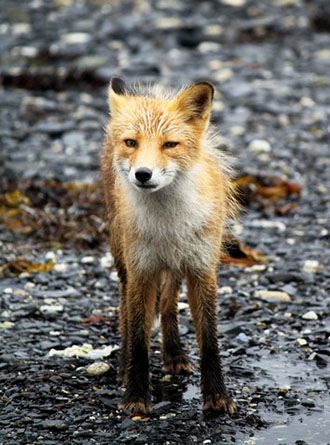
The Norton Sound Regional Health Corporation requested that Wildlife Services conduct Arctic fox removal in Savoonga due to concerns of rabies and distemper. After consultation and concurrence with ADF&G, WS split their four-man crew and sent two biologists to Savoonga (April 1-5) to conduct Arctic fox removal and collect brain samples to test for rabies and distemper. In total, Wildlife Services removed 46 Arctic fox during the four days, and local residents provided an additional ten. At the conclusion of the operation an additional fox exhibiting strange behaviors was kill by a local resident. Forty-six brain samples, and the head of the fox acting strangely, were taken back to Nome and tested for rabies by Wildlife Services biologists. Most of the fox removed in Savoonga were located near a whale carcass harvested last fall and buried under the snow. The foxes were burrowing through the snow and into the whale carcass to feed. The carcass was located on the eastern side of the community along the shoreline. The preliminary results showed no rabies positive tests from Savoonga, but previously four rabies positive arctic foxes killed in the village had been confirmed with rabies by CDC. Brain samples were also collected for distemper testing.
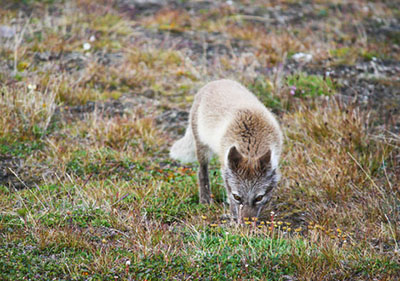
Given the prevalence of the rabies virus in Western and Northern Alaska, and the regular occurrences of rabies outbreaks near villages, ADF&G and WS are planning to determine what options are available to develop an Alaskan rabies surveillance and management program. Rabies vaccination of pet dogs remains the most critical step in preventing rabies exposure to Alaskans. But control of stray and feral dog populations will also need to be addressed. There may be more that can be done, including providing oral vaccination baits for foxes in surrounding key locations. Unfortunately, the current oral vaccination baits will not work if they are frozen so that hurdle remains a major problem. It's unknown what environmental factors precipitated this severe outbreak but changes in sea ice and prey availability affecting the distribution - and contact between - Arctic and red fox populations likely contributed. What the future holds is an open question but since rabies outbreaks occur every year to some degree, it's important to be prepared for future repeats of outbreaks similar to 2020-2021.
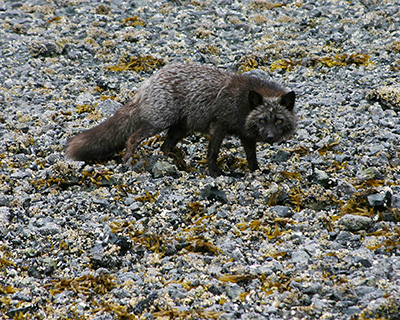
The response to the rabies situation in Nome highlights how cooperative actions of multiple agencies and entities can come together in a crisis to mitigation a human health as well as animal health emergency.
Video: Red fox having seizures consistent with the terminal stage of rabies
Safety Precautions for Rabies Outbreak in Bering Strait Region and Western Alaska
More on Rabies AFWN article from 2012 highlighting a rabid wolverine
Dr. Kimberlee Beckmen is ADF&G Wildlife Health Veterinarian, based in Fairbanks.
Subscribe to be notified about new issues
Receive a monthly notice about new issues and articles.
